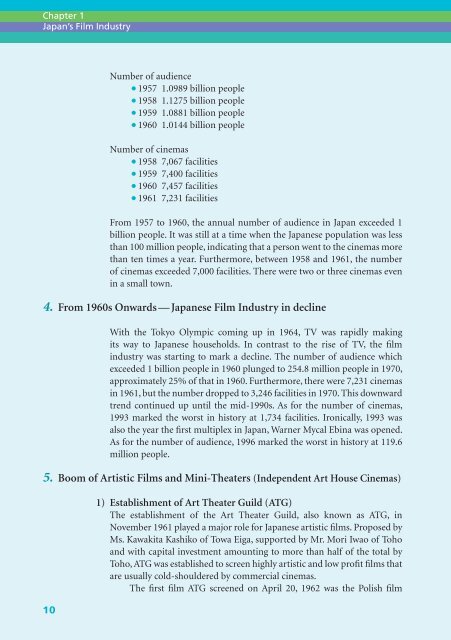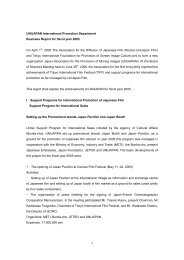The Guide to Japanese Film Industry & Co -Production - UNIJAPAN
The Guide to Japanese Film Industry & Co -Production - UNIJAPAN
The Guide to Japanese Film Industry & Co -Production - UNIJAPAN
Create successful ePaper yourself
Turn your PDF publications into a flip-book with our unique Google optimized e-Paper software.
Chapter 1<br />
Japan’s <strong>Film</strong> <strong>Industry</strong> Postwar <strong>Japanese</strong> <strong>Film</strong> <strong>Industry</strong> and Development<br />
Number of audience<br />
¡1957 1.0989 billion people<br />
¡1958 1.1275 billion people<br />
¡1959 1.0881 billion people<br />
¡1960 1.0144 billion people<br />
Number of cinemas<br />
¡1958 7,067 facilities<br />
¡1959 7,400 facilities<br />
¡1960 7,457 facilities<br />
¡1961 7,231 facilities<br />
From 1957 <strong>to</strong> 1960, the annual number of audience in Japan exceeded 1<br />
billion people. It was still at a time when the <strong>Japanese</strong> population was less<br />
than 100 million people, indicating that a person went <strong>to</strong> the cinemas more<br />
than ten times a year. Furthermore, between 1958 and 1961, the number<br />
of cinemas exceeded 7,000 facilities. <strong>The</strong>re were two or three cinemas even<br />
in a small <strong>to</strong>wn.<br />
4. From 1960s Onwards — <strong>Japanese</strong> <strong>Film</strong> <strong>Industry</strong> in decline<br />
With the Tokyo Olympic coming up in 1964, TV was rapidly making<br />
its way <strong>to</strong> <strong>Japanese</strong> households. In contrast <strong>to</strong> the rise of TV, the film<br />
industry was starting <strong>to</strong> mark a decline. <strong>The</strong> number of audience which<br />
exceeded 1 billion people in 1960 plunged <strong>to</strong> 254.8 million people in 1970,<br />
approximately 25% of that in 1960. Furthermore, there were 7,231 cinemas<br />
in 1961, but the number dropped <strong>to</strong> 3,246 facilities in 1970. This downward<br />
trend continued up until the mid-1990s. As for the number of cinemas,<br />
1993 marked the worst in his<strong>to</strong>ry at 1,734 facilities. Ironically, 1993 was<br />
also the year the first multiplex in Japan, Warner Mycal Ebina was opened.<br />
As for the number of audience, 1996 marked the worst in his<strong>to</strong>ry at 119.6<br />
million people.<br />
5. Boom of Artistic <strong>Film</strong>s and Mini-<strong>The</strong>aters (Independent Art House Cinemas)<br />
1) Establishment of Art <strong>The</strong>ater Guild (ATG)<br />
<strong>The</strong> establishment of the Art <strong>The</strong>ater Guild, also known as ATG, in<br />
November 1961 played a major role for <strong>Japanese</strong> artistic films. Proposed by<br />
Ms. Kawakita Kashiko of Towa Eiga, supported by Mr. Mori Iwao of Toho<br />
and with capital investment amounting <strong>to</strong> more than half of the <strong>to</strong>tal by<br />
Toho, ATG was established <strong>to</strong> screen highly artistic and low profit films that<br />
are usually cold-shouldered by commercial cinemas.<br />
<strong>The</strong> first film ATG screened on April 20, 1962 was the Polish film<br />
Mother Joanna of the Angels directed by Jerzy Kawalerowicz which ranked<br />
6th place in Kinema Junpo Top Ten (imported films). <strong>The</strong> following list<br />
consists some of the films by ATG. <strong>The</strong>y were screened at Nichigeki Bunka<br />
which used <strong>to</strong> be in the underground floor of Nichigeki <strong>The</strong>ater and<br />
Shinjuku Bunka in Shinjuku.<br />
Imported <strong>Film</strong>s:<br />
Wild Strawberries (Smuktron-Stallet)<br />
st [<br />
1962 Ingmar Bergman 1<br />
<strong>The</strong> Seventh Seal (Det Sjunde Inseglet)<br />
th [<br />
1963 Ingmar Bergman 6<br />
Shoot the Piano Player (Tirez sur le pianiste)<br />
th [<br />
1963 Francois Truffaut 9<br />
<strong>The</strong> Long Absence (Une aussi longue absence)<br />
st [<br />
1964 Henri <strong>Co</strong>lpi 1<br />
Last Year at Marienbad (L’Anné dernière á Marienbad)<br />
rd [<br />
1964 Alain Resnais 3<br />
[ rank for Kinema Junpo Top Ten (imported films)<br />
Works screened by ATG continued <strong>to</strong> rank in the Kinema Junpo Top Ten.<br />
ATG also played a key role for <strong>Japanese</strong> films as well.<br />
A Man Vanishes (Ningen johatsu) 1967 Imamura Shohei nd [ 2<br />
Manual of Ninja Martial Arts (Ninja bugei-cho)<br />
1967 Oshima Nagisa<br />
<strong>The</strong> Human Bullet: Human Guinea Pigs (Nikudan)<br />
th [ 10<br />
nd [<br />
1968 Okamo<strong>to</strong> Kihachi 2<br />
Death by Hanging (Koshikei) 1968 Oshima Nagisa rd [ 3<br />
Nanami: <strong>The</strong> Inferno of First Love (Hatsukoi: Jigoku-hen)<br />
1968 Hani Susumu<br />
Double Suicide (Shinju ten no Amijima)<br />
th [ 6<br />
st [<br />
1969 Shinoda Masahiro 1<br />
Boy (Shonen) 1969 Oshima Nagisa rd [ 3<br />
[ rank for Kinema Junpo Top Ten (<strong>Japanese</strong> films)<br />
2) Age of Mini-<strong>The</strong>aters<br />
In 1978, <strong>Co</strong>nversation Piece (Gruppo di Famiglia in un Interno) (directed<br />
by: Luchino Visconti, distributed by: Toho-Towa = Shibata Organization)<br />
was screened at Iwanami Hall, and recorded a long-running hit. <strong>The</strong><br />
following year, in 1979, <strong>The</strong> Travelling Players (O Thiassos) (directed<br />
by: <strong>The</strong>o Angelopoulos, distributed by: Shibata Organization) was also<br />
screened at Iwanami Hall and again marked a long-running hit. <strong>The</strong>se two<br />
10 11




